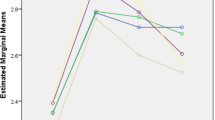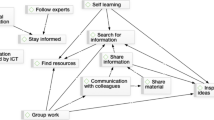Abstract
This study aimed to investigate medical students’ evaluation of using Telegram as a Social Networking Site (SNS) in English for Specific Academic Purposes (ESAP) programs. To this end, the students’ explanatory responses about the merits and demerits of the SNS as well as their suggestions for improving its educational usability were collected. The qualitative data analysis of the students’ responses showed the merit codes of accessibility, data exchange, group learning, competitive atmosphere, peer-checking, and time-saving. The demerit codes emerging from the analysis were dependence and cheating, distrust, addiction, distraction, Internet problems, lack of supervision and lack of instruction. The codes derived from the students’ propositions were upgrading the SNS, dynamic atmosphere, blended-learning, teacher involvement, culture of using the platform, cooperative learning, appropriacy of the materials and type of the materials. The findings indicated that the trend of the students’ views about the merits of the site centered on technical categories, their views about the demerits of the system revolved mainly around behavioral categories and their propositions were closely linked to educational categories. The data analysis also showed significant differences in the perceived significance of the codes to the students with accessibility, Internet problems and type of the materials being the most prominent ones in the merit, demerit, and proposition codes respectively. From the findings, it can be concluded that educators should be encouraged to join the SNS to educationally support students, consider the merits and demerits of the SNS before employing it and improve the usability of the site based on the feedback they receive from students. The study suggests that a fine-tuned action plan be outlined with an eye to the technical, educational and behavioral requirements for using the SNS. It is also recommended that educators’ and students’ level and range of activities as well as ethical codes of conduct on the SNS be clearly stipulated in the course plan of programs involving the use of the site.
Similar content being viewed by others
References
Allen, I. E., & Seaman, J. (2003). Sizing the opportunity: The quality and extent of online education in the United States, 2002 and 2003. Wellesley, MA: Sloan Center for Online Education.
Asemi, A. (2005). Information searching habits of internet users: A case study on the Medical Sciences University of Isfahan, Iran. Webology, 2(1), 10.
Asgari, A., & Khaghanizadeh, M. (2010). Multimedia method of education. Education Strategy in Medical Sciences, 2(4), 173–176.
Azer, S. A. (2012). Can “YouTube” help students in learning surface anatomy? Surgical and Radiologic Anatomy, 34(5), 465–468.
Bhasin, B. (2012). Integration of information and communication technologies in enhancing teaching and learning. Contemporary Educational Technology, 3(2), 130–140.
Blanchard, M., Metcalf, A., & Burns, J. (2007). Bridging the digital divide: creating opportunities for marginalised young people to get connected, Research Report No 1, Inspire Foundation and Orygen Youth Health Research Centre, Centre for Youth Mental Health, University of Melbourne.
Bonk, C. J., & Graham, C. R. (2012). The handbook of blended learning: Global perspectives, local designs: John Wiley & Sons.
Boyd, D. (2014). It's complicated: The social lives of networked teens. New Haven, CT: Yale University Press.
Boyd, D. M., & Ellison, N. B. (2007). Social network sites: Definition, history, and scholarship. Journal of Computer-Mediated Communication, 13(1), 210–230. https://doi.org/10.1111/j.1083-6101.2007.00393.x.
Caplan, S. E. (2002). Problematic Internet use and psychosocial well-being: development of a theory-based cognitive–behavioral measurement instrument. Computers in Human Behavior, 18(5), 553–575.
Carroll, C. L., Bruno, K., & vonTschudi, M. (2016). Social media and free open access medical education: the future of medical and nursing education? American Journal of Critical Care, 25(1), 93–96.
Chou, C., & Hsiao, M. C. (2000). Internet addiction, usage, gratification, and pleasure experience: the Taiwan college students’ case. Computers & Education, 35(1), 65–80.
Dalsgaard, C., & Paulsen, M. F. (2009). Transparency in cooperative online education. The International Review of Research in Open and Distance Learning, 10(3), 1–22.
Davies, P., & Pearse, D. (2008). Success in english teaching. Oxford: Oxford University Press.
Davis, R. A. (2001). A cognitive-behavioral model of pathological Internet use. Computers in Human Behavior, 17(2), 187–195.
D'Souza, K., Henningham, L., Zou, R., Huang, J., O'Sullivan, E., Last, J., & Ho, K. (2017). Attitudes of health professional educators toward the use of social media as a teaching tool: global cross-sectional study. JMIR Medical Education, 3(2), e13.
Ebrahimpour, A., Rajabali, F., Yazdanfar, F., Azarbad, R., Nodeh, M. R., Siamian, H., & Vahedi, M. (2016). Social network sites as educational factors. Acta Informatica Medica, 24(2), 134.
Erfanian, M., Javadinia, A., Abedini, M., & Bijar, B. (2013). iranian students and social networking sites: Prevalence and pattern of usage. Procedia-Social and Behavioral Sciences, 83(4), 44–46.
Griffiths, M. (2000). Does Internet and computer" addiction" exist? Some case study evidence. CyberPsychology and Behavior, 3(2), 211–218.
Huffstutler, S., Wyatt, T. H., & Wright, C. P. (2002). The use of handheld technology in nursing education. Nurse Educator, 27(6), 271–275.
Ito, M., & Okabe, D. (2005). Technosocial situations: Emergent structurings of mobile email use. Personal, portable, pedestrian: Mobile phones in Japanese life, 20(6), 257–273.
Ito, M., Horst, H., Bittanti, M., Boyd, D., Herr-Stephenson, B., Lange, P., Pascoe, C., & Robinson, L. (2008). Living and learning with new. Media: Summary of findings from the digital youth project. Chicago, IL: MacArthur Foundation.
Jalali, A. W. T. (2013). Tweeting during conferences: education or just another distraction? Medical Education, 47(11), 1119–1145.
Jalali, A. S. J., Frank, F., & Sutherland, S. (2015). Social media and medical education: exploring the potential of Twitter as a learning tool. International Review of Psychiatry, 27(2), 140–146.
Kaplan, A. M., & Haenlein, M. (2010). Users of the world, unite! The challenges and opportunities of Social Media. Business Horizons, 53, 59–68.
Kuppuswamy, S., & Narayan, P. (2010). The impact of social networking websites on the education of youth. International Journal of Virtual Communities and Social Networking (IJVCSN), 2(1), 67–79.
Lenhart, A., & Madden, M. (2007). Social networking websites and teens. Washington, D. C: PEW Research Center.
Liccardi, I., Ounnas, A., Pau, R., Massey, E., Kinnunen, P., Lewthwaite, S., & Sarkar, C. (2007). The role of social networks in students' learning experiences. ACM Sigcse Bulletin, 339(4), 224–237.
Lin, C. H., Warschaer, M., & Blake, R. (2016). Language learning through social networks: Perceptions and reality. Language Learning & Technology, 20(1), 124–147.
Milliken, J., & Barnes, L. P. (2002). Teaching and technology in higher education: student perceptions and personal reflections. Computers & Education, 39(3), 223–235.
Mitchell, K. (2012). A social tool: Why and how ESOL students use Facebook. CALICO Journal, 29(3), 471.
Nunan, D., & Carter, R. (2001). The Cambridge guide to teaching English to speakers of other languages: Ernst Klett Sprachen.
Pant, S., Deshmukh, A., Murugiah, K., Kumar, G., Sachdeva, R., & Mehta, J. L. (2012). Assessing the credibility of the “YouTube approach” to health information on acute myocardial infarction. Clinical Cardiology, 35(5), 281–285.
Rabbani, M. J., A. Asif, M. Ibrahim, M. (2015). Impact of social networking websites on students learning. New Media and Mass Communication, 44(1), 15–50.
Ramaley, J. (2005). The real versus the possible: How students use technology. In D. Oblinger & J. Oblinger (Eds.), Educating the net generation (pp. 8.1–8.21) [E-book]. Retrieved November 17, 2017, from http://www.educause.edu/ir/library/pdf/pub7101.pdf.
Richardson, I., Third, A., MacColl, I., Wong, K. K. W., Fung, L. C. C., & Cole, P. (2007). Moblogging and belonging: new mobile phone practices and young people's sense of social inclusion. Proceedings of the second international conference on digital interactive media in entertainment and arts: DIMEA 2007, 19–21 September 2007, Perth, Western Australia.
Saifollahi, S. (2015). The role of new social networks in changing the behavior of Iranian girls and women students. Stud Soci Dev Iran, 7(2), 31–52.
Salaway, G., Caruso, J. B., & Nelson, M. R. (2008). The ECAR study of undergraduate students and information technology, 2008. In Research study (Vol. 8). Boulder, CO: EDUCAUSE Center for Applied Research.
Stevenson, M. P., & Liu, M. (2010). Learning a language with Web 2.0: Exploring the use of social networking features of foreign language learning websites. CALICO Journal, 27(2), 233–259.
Sutherland, S., & Jalali, A. (2017). Social media as an open-learning resource in medical education: current perspectives. Advances in Medical Education and Practice, 8, 369–375. https://doi.org/10.2147/AMEP.S112594.
Tess, P. A. (2013). The role of social media in higher education classes (real and virtual)–A literature review. Computers in Human Behavior, 29(5), A60–A68.
Vie, S. (2007). Engaging others in online social networking sites: Rhetorical practices in MySpace and Facebook. University of Arizona, Tucson, AZ: Unpublished doctoral dissertation.
What can you do with Telegram? (n.d.). Retrieved from telegram messenger: https://telegram.org/.
Widyanto, L., & Griffiths, M. (2006). ‘Internet addiction’: a critical review. International Journal of Mental Health and Addiction, 4(1), 31–51.
Xodabande, E., & Popescu, M. (2017). The effectiveness of social media network telegram in teaching English language pronunciation to Iranian EFL learners. Cogent Education, 4(1), 1–14.
Yaghoubi, J., Mohammadi M. I., Iravani, H., Attaran, M., & Gheidi, A. (2008). Virtual students' perceptions of e-learning in Iran. The Turkish Online Journal of Educational Technology, 7(3), 89–95.
Zaidieh, A. J. Y. (2012). The use of social networking in education: Challenges and opportunities. World of Computer Science and Information Technology Journal (WCSIT), 2(1), 18–21.
Author information
Authors and Affiliations
Corresponding author
Rights and permissions
About this article
Cite this article
Alizadeh, I. Evaluating the educational usability of Telegram as an SNS in ESAP programs from medical students’ perspective. Educ Inf Technol 23, 2569–2585 (2018). https://doi.org/10.1007/s10639-018-9731-5
Received:
Accepted:
Published:
Issue Date:
DOI: https://doi.org/10.1007/s10639-018-9731-5




